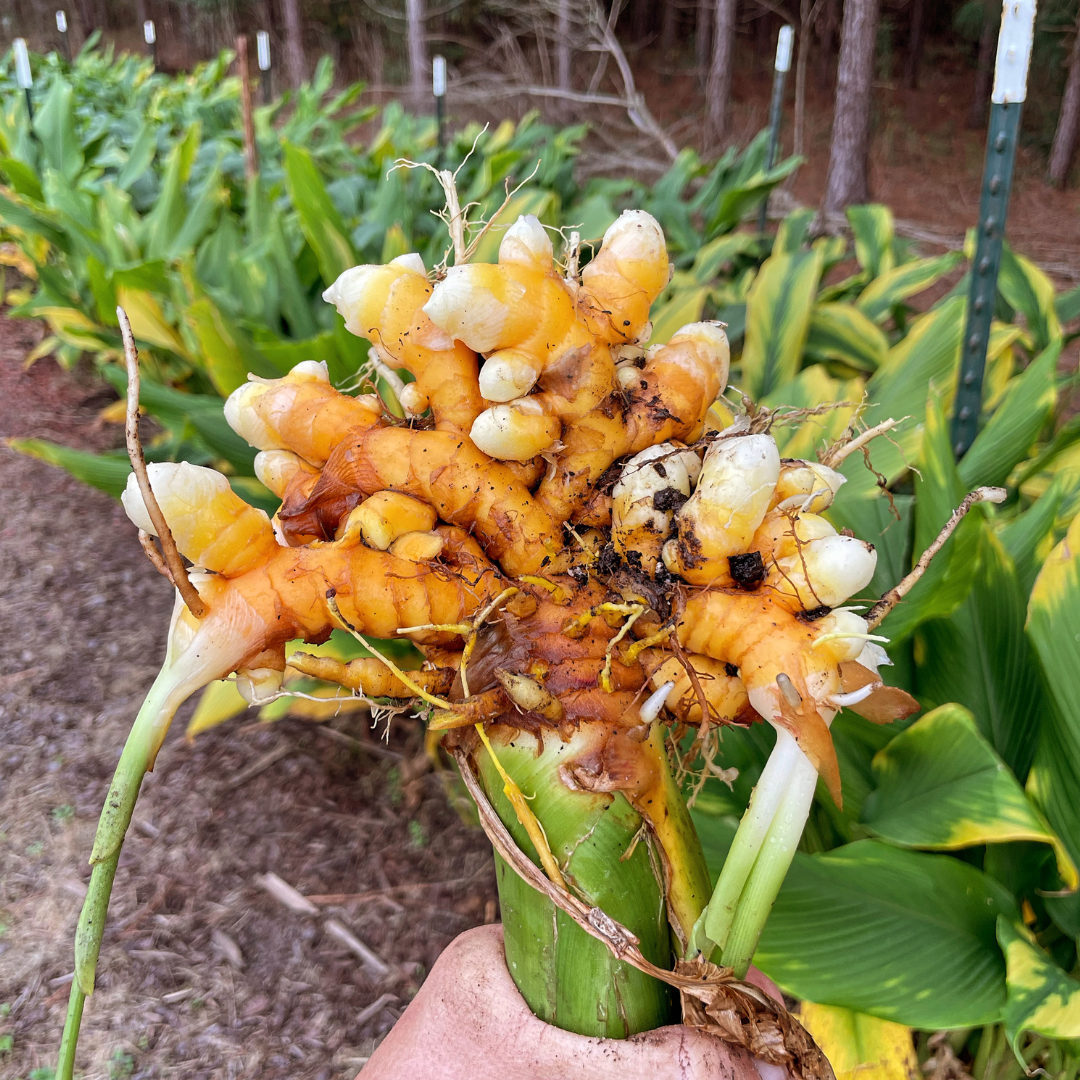We love trying to grow things we've never grown and learning about the process as we go. One of the things we've really enjoyed learning how to grow is turmeric. A couple years ago a viewer sent us a small ziploc bag of turmeric tubers and suggested we give it a try. We've since graduated to growing rows and rows of turmeric, and below we'll share what we've learned.
The Growing Turmeric Journey
Turmeric is grown from the tubers that form under the ground as the plant grows. As mentioned above, we started with just a few small pieces that a viewer sent us in 2021. We planted these in one of the raised beds beside our barn and the plants did pretty well considering it was our first try.
We harvested approximately a gallon ziploc bag of turmeric from that little raised bed. We dried and ground about half of it to use in smoothies and other kitchen applications. We kept the other half in the fridge so we could use it for seed stock the following year.
The next year we tried planting our turmeric much earlier. The first planting in the raised bed was done in mid-summer, but we wanted to get an earlier start with our 2022 planting. We also wanted to try growing it in the ground on a larger scale.
We planted one 40' row of turmeric in one of our in-ground garden plots and placed that row close to a pine forest that borders our property. We had heard that turmeric performs best in partial shade and so we figured planting next to those pine trees would help give it some shade on our hot summer days.

This second year was decent, but we didn't get the per-plant production that we got the first year in the single raised bed. I think shade played a big factor here. While that row of in-ground turmeric did get some shade from the pine trees, it didn't get near as much shade as that small raised bed does.
You could tell the turmeric plants were suffering on hot summer days because the leaves would curl and then would uncurl late in the afternoon once the sun started to set. This told us that we needed to either rethink our turmeric growing location or add some shade cloth the following year.
We chose the latter. This year (2023) we used our 2022 harvest and planted even more in-ground turmeric. Instead of one 40' row, we had five 40' rows that were planted relatively close. We had drip tape buried under each row to keep them watered and happy.
We also transplanted the turmeric this year instead of just putting the turmeric pieces in the ground. We started the turmeric in the greenhouse, pre-sprouted it, and then transferred those plants to the in-ground garden. The idea was to get a longer growing season with our turmeric, and this process worked very well.
We also installed a shade cloth setup that covered all five rows. The benefits of this were seen immediately. The plants were no longer curled and struggling on hot days, and we saw much more growth from our turmeric plants.
Our third year turmeric harvest (this year) was interesting. Some of the plants had the biggest turmeric roots I've ever seen, while others were a little underwhelming. But as long as we can learn from what we've seen, it's never considered a loss. So here's what we learned.

Our Best Turmeric Growing Tips
1. Leave Some in the Ground
When harvesting turmeric, it's almost impossible to get it all. You're always going to leave a little in the ground, even if you're not trying to do that. And those tubers left in the ground will voluntarily sprout the following year once the soil warms in early to mid summer.
Some of our biggest plants and biggest harvests this year came from volunteers. This tells us that there is a huge benefit to growing turmeric like a perennial and leaving some of it in the ground. It seems to produce even better the second year it is left in the ground.
As a result, we only harvested the larger plants in our turmeric plot this year. We knew those smaller plants were going to provide average or below average harvests, so we felt it was best to just leave them and let them hit a home run next year.
2. Give It Some Shade
Although turmeric is a tropical plant and thrives in warmer climates, it definitely doesn't like being in full sun during our south Georgia summers. It prefers a little shade and seems to grow much better when the plants don't get stressed by the intense heat.
If you're growing turmeric in pots or containers, consider putting those pots or containers under a large shade tree or on a side of your house that doesn't get much sun. If most of your property is in direct sun, shade cloth is a great way to give the plants some relief.

3. Turmeric Loves Water
As mentioned above, we had drip tape under all five turmeric rows this past year and we used it! We gave it as much water as we give sweet corn, which is a lot. It was amazing how much water those turmeric rows could absorb and it never seemed as if the soil was oversaturated.
From just our three years growing turmeric, it appears that they are very thirsty plants. Assuming you have soil that drains relatively well, it's almost impossible to overwater it. Keep it happy with frequent watering and you'll be rewarded.

4. Extend the Growing Season
When turmeric tubers are planted in the ground, they won't sprout until soil temperatures get pretty warm in early to mid summer. Depending on where you live, this may mean that you would have a pretty short turmeric growing season. One way to extend the growing season is through pre-sprouting.
We kept it really simple using some bottom trays in our greenhouse. We filled the bottom trays with ProMix and pushed the little pieces of turmeric into the pre-moistened seed starting mix. We then lightly covered with more ProMix and kept the trays warm with a heat mat.
In just a couple weeks this spring, the turmeric had sprouted and started growing. Once the sprouts were a few inches tall, we plucked them from the soil in the bottom trays and transplanted them to the in-ground garden. This worked great to get a longer growing season from the turmeric, which meant bigger harvests at the end of the year.

Fun and Easy to Grow
We hope you've enjoyed learning about our turmeric journey and hope these tips will encourage you try growing turmeric in your backyard garden, whether that be in containers or an in-ground garden. Once you grow it successfully, you'll have tubers to replant year after year. To see our harvest from this past year and learn more, watch this video.

